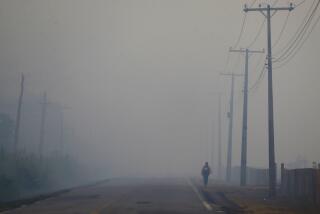Brazilian Law Stretches Its Arm Into Untamed Amazon
- Share via
MANAUS, Brazil — Many have tried and failed to conquer the Amazon rain forest, a fabled, 4,000-mile stretch of untamed green.
Too dense, dark and vast to be monitored or controlled, Brazil’s Amazon region -- home to the greatest variety of life on Earth -- has provided haven to smugglers of drugs, arms and timber. U.S. and Brazilian officials have come to fear that anti-Western extremists might also find cover in the 2-million-square-mile expanse.
The lawlessness of the jungle, these officials say, is in its last days as the Amazon Surveillance System nears completion. From a dozen white brick buildings outside the former rubber capital of Manaus, Brazilian civilian and military authorities are using satellites, surveillance aircraft and sensors in the wild, muddy Amazon River and on the ground to create the first complete radar picture of this outback.
Since the spy center began operating in 2002, the military has used it to cut drug shipments across the borders with Columbia, Peru and Bolivia by a third, officials say. It has enabled the Brazilian air force to locate and destroy airstrips used by narcotics smugglers and illicit miners and loggers.
“I call it probably the most ambitious technological undertaking in South America,” said a senior U.S. defense official who visited here Wednesday with Pentagon chief Donald H. Rumsfeld. “We think it’s a shining example of what can be done.”
Rumsfeld, who was visiting military allies in Latin America, went to Manaus to see the system at work. The Pentagon plans to buy 56 of the high-tech surveillance aircraft the network uses. They are built in Brazil but incorporate a substantial amount of U.S. technology.
U.S. authorities are particularly concerned about the trade in arms and drugs, areas in which the Amazon Surveillance System, known by its Portuguese acronym, SIVAM, has had an effect. Brig. Gen. Ricardo Machado Vieira, chief of air defense operations, showed Rumsfeld a slide on which were traced dozens of blue lines over the Brazil-Colombia border -- unidentified planes following a well-known drug route, he said.
“It is an impressive accomplishment for the Brazilian government and the people of Brazil,” Rumsfeld said. “We wanted to have an opportunity to see what they had done and to learn from it.”
Unlike the analogous NORAD network in North America, SIVAM’s mission extends beyond the military. In April, environmental authorities plan to use the system to help measure the annual increase in the ecologically sensitive region’s deforestation. Air traffic controllers who used to lose track of planes headed for Manaus are now on constant watch.
Perhaps it’s a pipe dream for a region that includes some of the world’s most destitute areas, but Brazilian and U.S. officials would like to see other Latin American nations combat narcotics, illegal mining and ordinary crime by copying the program. It could also be used against arms smuggling tied to militant groups.
“The Brazilians are trying to develop ties with other countries to share the information,” the U.S. defense official traveling with Rumsfeld said. “I think it will help at once to protect and intelligently develop the parts of the Amazon that are going to be developed.”
*
Hendren was on assignment in Manaus this week.
More to Read
Sign up for Essential California
The most important California stories and recommendations in your inbox every morning.
You may occasionally receive promotional content from the Los Angeles Times.













